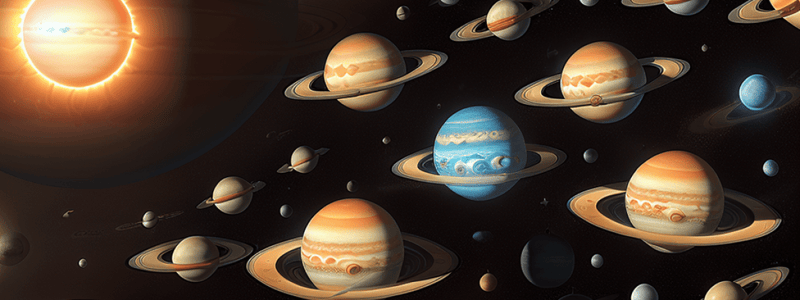Podcast
Questions and Answers
The Solar System is composed of the Sun and the objects that orbit it.
The Solar System is composed of the Sun and the objects that orbit it.
True (A)
There are nine planets in the Solar System.
There are nine planets in the Solar System.
False (B)
The gas giants in the Solar System are mostly made of hydrogen and helium.
The gas giants in the Solar System are mostly made of hydrogen and helium.
True (A)
The ice giants in the Solar System are mostly made of rock and metal.
The ice giants in the Solar System are mostly made of rock and metal.
The Solar System was formed from the gravitational collapse of a giant interstellar molecular cloud.
The Solar System was formed from the gravitational collapse of a giant interstellar molecular cloud.
The largest of such objects are the ______ planets, in order from the Sun: four terrestrial planets named Mercury, Venus, Earth and Mars, two gas giants named Jupiter and Saturn, and two ice giants named Uranus and Neptune.
The largest of such objects are the ______ planets, in order from the Sun: four terrestrial planets named Mercury, Venus, Earth and Mars, two gas giants named Jupiter and Saturn, and two ice giants named Uranus and Neptune.
The ______ planets have a definite surface and are mostly made of rock and metal.
The ______ planets have a definite surface and are mostly made of rock and metal.
The gas giants are mostly made of ______, while the ice giants are mostly made of 'volatile' substances such as water, ammonia, and methane.
The gas giants are mostly made of ______, while the ice giants are mostly made of 'volatile' substances such as water, ammonia, and methane.
In some texts, these terrestrial and giant planets are called the inner Solar System and outer Solar System planets respectively.
In some texts, these terrestrial and giant planets are called the inner Solar System and outer Solar System planets respectively.
The Solar System was formed 4.6 billion years ago from the gravitational collapse of a giant interstellar molecular cloud. Over time, the cloud formed the Sun and a protoplanetary disk that gradually coalesced to form planets and other objects. That is the reason why all eight planets have an orbit that lies ______.
The Solar System was formed 4.6 billion years ago from the gravitational collapse of a giant interstellar molecular cloud. Over time, the cloud formed the Sun and a protoplanetary disk that gradually coalesced to form planets and other objects. That is the reason why all eight planets have an orbit that lies ______.
Flashcards
What is the Solar System?
What is the Solar System?
The Solar System includes the Sun and all objects orbiting it.
Are there nine planets?
Are there nine planets?
False. There are eight planets in the Solar System.
Gas giant composition?
Gas giant composition?
True. Gas giants are primarily composed of hydrogen and helium.
Ice giant composition?
Ice giant composition?
Signup and view all the flashcards
Formation of the Solar System
Formation of the Solar System
Signup and view all the flashcards
Largest objects orbiting the sun?
Largest objects orbiting the sun?
Signup and view all the flashcards
Terrestrial planet composition
Terrestrial planet composition
Signup and view all the flashcards
Gas giant main components?
Gas giant main components?
Signup and view all the flashcards
Location of terrestrial and giant planets
Location of terrestrial and giant planets
Signup and view all the flashcards
Study Notes
Solar System Overview
- Composed of the Sun and various objects orbiting it.
- Contains nine planets classified into two main categories: terrestrial and giant.
Planet Classification
- Terrestrial Planets: Mercury, Venus, Earth, Mars; characterized by a definite surface, primarily composed of rock and metal.
- Gas Giants: Jupiter and Saturn; primarily made of hydrogen and helium.
- Ice Giants: Uranus and Neptune; mainly consist of volatile substances like water, ammonia, and methane.
Formation of the Solar System
- Formed approximately 4.6 billion years ago from the gravitational collapse of an interstellar molecular cloud.
- The collapsing cloud formed the Sun and a protoplanetary disk that evolved into planets and other celestial objects.
Orbital Characteristics
- All eight planets have orbits that lie in a specific plane, aligned due to the formation process from the protoplanetary disk.
Additional Notes
- The inner planets (terrestrial) are distinct from the outer planets (gas and ice giants) in terms of composition and physical characteristics.
Studying That Suits You
Use AI to generate personalized quizzes and flashcards to suit your learning preferences.




